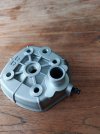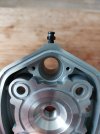Vandaag kreeg ik mijn Stage6 50cc streetrace cilinder kit binnen voor mijn aerox. Het viel me op dat er maar 1 aansluiting tbv de carburateur verwarming op zit ipv 2 op de standaard cilinderkop. Heeft iemand een idee waar ik de 2e slang op moet aansluiten?
Zelf dacht ik aan een T-stukje (luchtpomp aquarium oid) maar weet niet of dit een goed idee is. 1 slang na ontluchten afsluiten zou ook nog kunnen volgens mij maar hoor graag jullie mening...
Zelf dacht ik aan een T-stukje (luchtpomp aquarium oid) maar weet niet of dit een goed idee is. 1 slang na ontluchten afsluiten zou ook nog kunnen volgens mij maar hoor graag jullie mening...


